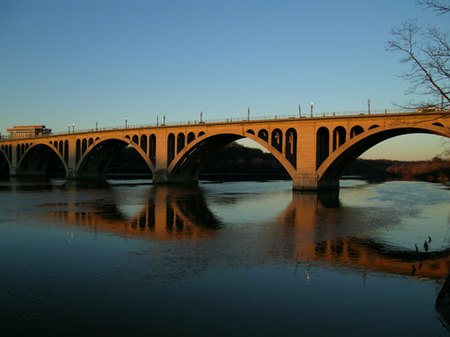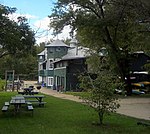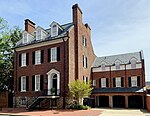Key Bridge (Washington, D.C.)
1923 establishments in VirginiaBridges completed in 1923Bridges of the United States Numbered Highway SystemBridges over the Potomac RiverBuildings and structures in Arlington County, Virginia ... and 15 more
Concrete bridges in the United StatesGeorgetown (Washington, D.C.)Harv and Sfn no-target errorsHistoric American Engineering Record in Washington, D.C.National Register of Historic Places in Arlington County, VirginiaNeoclassical architecture in VirginiaNeoclassical architecture in Washington, D.C.Open-spandrel deck arch bridges in the United StatesRoad bridges in VirginiaRoad bridges in Washington, D.C.Road bridges on the National Register of Historic Places in VirginiaRoad bridges on the National Register of Historic Places in Washington, D.C.Transportation in Arlington County, VirginiaU.S. Route 29Use mdy dates from September 2019

The Francis Scott Key Bridge, more commonly known as the Key Bridge, is a six-lane reinforced concrete arch bridge conveying U.S. Route 29 (US 29) traffic across the Potomac River between the Rosslyn neighborhood of Arlington County, Virginia, and the Georgetown neighborhood of Washington, D.C. Completed in 1923, it is Washington's oldest surviving road bridge across the Potomac River. Key Bridge was added to the National Register of Historic Places in 1996.
Excerpt from the Wikipedia article Key Bridge (Washington, D.C.) (License: CC BY-SA 3.0, Authors, Images).Key Bridge (Washington, D.C.)
Francis Scott Key Bridge, Washington Georgetown
Geographical coordinates (GPS) Address External links Nearby Places Show on map
Geographical coordinates (GPS)
| Latitude | Longitude |
|---|---|
| N 38.902222222222 ° | E -77.070277777778 ° |
Address
Key Bridge
Francis Scott Key Bridge
20057 Washington, Georgetown
District of Columbia, United States
Open on Google Maps








